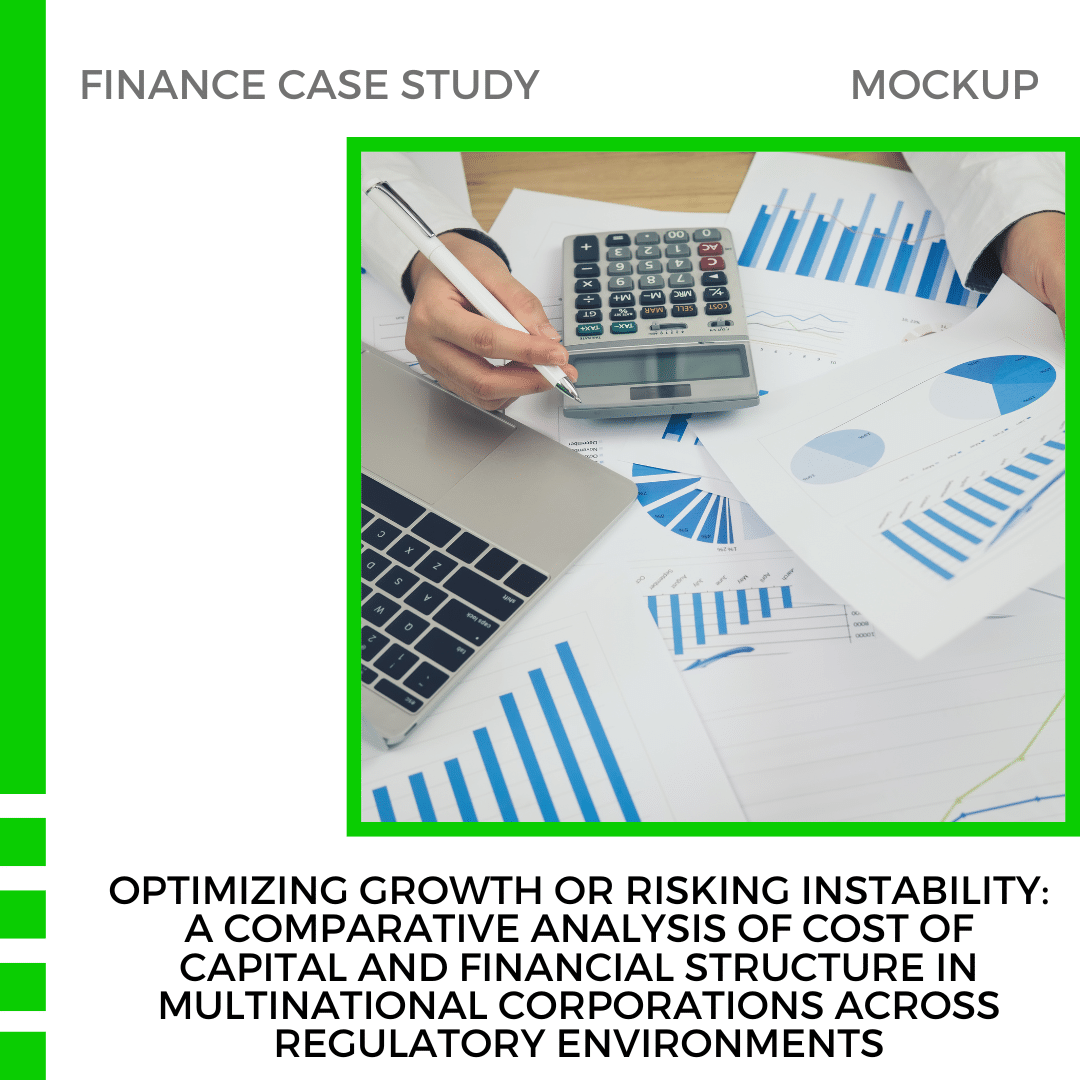
Optimizing Growth or Risking Instability: A Comparative Analysis of Cost of Capital and Financial Structure in Multinational Corporations Across Regulatory Environments
Introduction
Multinational corporations (MNCs) operate in diverse regulatory environments that shape their financial strategies. A comparative analysis of these environments reveals how financial structure and the cost of capital vary across regions. This case study examines the financial strategies of MNCs in North America, Europe, and Asia. Students will analyze the financial structures, assess the cost of capital components, and explore how regulations influence the trade-offs between debt and equity.
Comparative analysis is a powerful tool that helps businesses and analysts evaluate financial structures and performance across different contexts. In the case of multinational corporations (MNCs), comparative analysis becomes essential to understand how variations in regulatory environments, cost of capital, and financial strategies affect operations across regions. This case study focuses on using comparative analysis to examine the financial structures of MNCs in North America, Europe, and Asia. It highlights how companies adjust their cost of capital and capital structure based on region-specific regulatory requirements.
Through comparative analysis, students will explore the impact of different debt-to-equity ratios, Weighted Average Cost of Capital (WACC), and the cost of financing across these regions. Each section emphasizes how companies leverage financial tools differently depending on local tax policies and compliance demands. Comparative analysis also allows for a deeper understanding of how financial structures influence profitability, operational efficiency, and financial risk management.
This study will provide valuable insights by applying comparative analysis to real-world scenarios. It will help students evaluate the trade-offs between debt and equity financing in different regulatory landscapes. Comparative analysis will not only highlight the strengths and weaknesses of financial strategies but also equip students to recommend optimal solutions for region-specific challenges MNCs face.
Objectives
- Understand the concept of cost of capital and its components.
- Perform a comparative analysis of MNCs’ financial structures in different regulatory environments.
- Evaluate the impact of regional regulations on the cost of capital.
- Discuss the advantages and disadvantages of debt and equity financing across regions.
Background Information
Cost of Capital Components
- Debt Capital: Loans and other borrowed funds must be repaid with interest.
- Equity Capital: Funds invested by owners through the sale of shares.
Key Financial Metrics
- Weighted Average Cost of Capital (WACC): The overall cost of financing, reflecting the proportionate costs of debt and equity.
- Debt-to-Equity Ratio (D/E): A measure of leverage calculated as total debt divided by total equity.
- Return on Equity (ROE): A measure of profitability calculated as net income divided by shareholders’ equity.
- Earnings Before Interest and Taxes (EBIT): A key measure of operating performance.
Industry Analysis
Region 1: North America
Company A: Tech Global Inc.
- Financial Structure:
- Total Debt: $2,000 million
- Total Equity: $3,000 million
- D/E Ratio: 0.67
- Cost of Capital:
- Cost of Debt: 4%
- Cost of Equity: 8%
- WACC: 6%
- Regulatory Environment:
- Stringent financial reporting and disclosure requirements.
- Favorable tax policies that incentivize debt financing.
Region 2: Europe
Company B: Euro Manufacturing Plc.
- Financial Structure:
- Total Debt: $1,500 million
- Total Equity: $1,500 million
- D/E Ratio: 1.0
- Cost of Capital:
- Cost of Debt: 3%
- Cost of Equity: 7%
- WACC: 5%
- Regulatory Environment:
- High compliance costs due to detailed financial regulations.
- Moderate tax benefits from interest payments on debt.
Region 3: Asia
Company C: Asia Retail Corp.
- Financial Structure:
- Total Debt: $2,500 million
- Total Equity: $2,000 million
- D/E Ratio: 1.25
- Cost of Capital:
- Cost of Debt: 5%
- Cost of Equity: 10%
- WACC: 7%
- Regulatory Environment:
- Rapidly changing regulatory landscape with growing compliance demands.
- Limited tax benefits for debt financing, favouring equity capital.
Case Study Analysis
Task 1: Analyze Financial Structures
- Compare the Financial Structures:
- Calculate and compare the D/E ratios of Tech Global Inc., Euro Manufacturing Plc., and Asia Retail Corp.
- Discuss the implications of different D/E ratios on the firms’ financial risk and cost of capital.
Task 2: Evaluate Cost of Capital
- Assess WACC and Its Components:
- Compare the WACC of the three companies.
- Analyze how the regulatory environment in each region influences the cost of debt and equity and, consequently, the WACC.
Task 3: Discuss Advantages and Disadvantages
- Debt Financing:
- Advantages: Tax benefits from interest payments, leverage effect on ROE.
- Disadvantages: Financial risk due to fixed interest obligations and potential bankruptcy.
- Equity Financing:
- Advantages: No obligation to repay, lower financial risk.
- Disadvantages: Dilution of ownership, potentially higher cost of capital than debt.
Task 4: Region-Specific Considerations
1. North America:
- Discuss why companies prefer a balanced financial structure in a stringent regulatory environment.
- Consider the impact of favourable tax policies on capital structure decisions.2.
2. Europe:
- Evaluate the implications of high compliance costs on financial strategies.
- Consider the role of moderate tax benefits in choosing between debt and equity.
3. Asia:
- Analyze the impact of a rapidly evolving regulatory landscape on capital structure decisions.
- Consider the limited tax benefits for debt financing in the region.
Financial Statements for Comparative Analysis
Tech Global Inc. (North America)
| Metric | Amount |
|---|---|
| Total Debt | $2,000 million |
| Total Equity | $3,000 million |
| D/E Ratio | 0.67 |
| Cost of Debt | 4% |
| Cost of Equity | 8% |
| WACC | 6% |
Euro Manufacturing Plc. (Europe)
| Metric | Amount |
|---|---|
| Total Debt | $1,500 million |
| Total Equity | $1,500 million |
| D/E Ratio | 1.0 |
| Cost of Debt | 3% |
| Cost of Equity | 7% |
| WACC | 5% |
Asia Retail Corp. (Asia)
| Metric | Amount |
|---|---|
| Total Debt | $2,500 million |
| Total Equity | $2,000 million |
| D/E Ratio | 1.25 |
| Cost of Debt | 5% |
| Cost of Equity | 10% |
| WACC | 7% |
Possible Solution
MNCs should adopt a region-specific financial strategy to optimize their cost of capital. In regions like North America, companies can leverage debt to reduce WACC. Meanwhile, Asian firms should focus on maintaining financial flexibility through a higher equity proportion to navigate regulatory changes. European firms should prioritize balanced financial structures to meet compliance demands while optimizing costs. By adopting a hybrid financial strategy—combining local adaptation with a global framework—MNCs can optimize their cost of capital, reduce risks, and position themselves for sustainable growth in multiple regions.
Conclusion
This comparative analysis highlights how regulatory environments shape the financial strategies of MNCs. Companies operating in regions with favourable tax policies, such as North America, can benefit from using debt. In contrast, regions like Asia may need to rely more on equity financing to adapt to evolving regulations.
References
Harvard Business Review – Global Financial Strategies
This structured comparative analysis provides a comprehensive understanding of how MNCs navigate financial decisions across regions, helping students apply theoretical concepts to real-world situations.
Explore Business Models of Global Companies and Indian Companies



